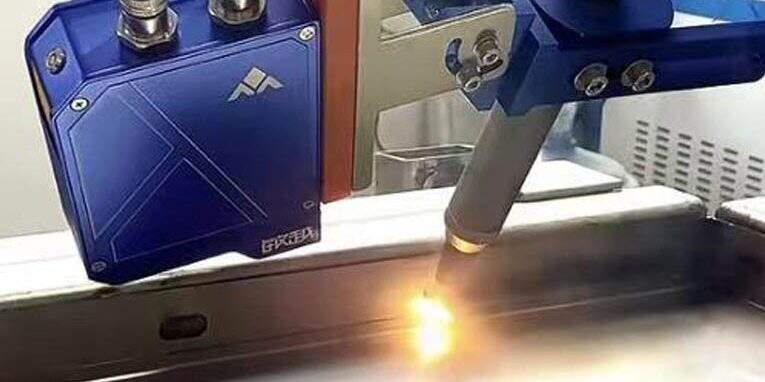
लेजर वेल्ड ट्रैकिंग सिस्टम मौजूदा वेल्डिंग उपकरणों के साथ कैसे जुड़ता है
औद्योगिक प्रौद्योगिकी आगे बढ़ती रहती है, सभी क्षेत्रों में वेल्डिंग की स्वचालन, लेजर वेल्डिंग सीमा ट्रैकिंग सिस्टम एक उन्नत वेल्डिंग सहायक उपकरण के रूप में, वेल्डिंग की सटीकता और कुशलता में महत्वपूर्ण सुधार कर सकता है, मानवीय पर्यवेक्षण को कम करता है, और उत्पादन लागत को कम करता है।
1. मौजूदा वेल्डिंग उपकरणों का मूल्यांकन
एक वेल्ड ट्रैकिंग सिस्टम को एकीकृत करने से पहले, मौजूदा वेल्डिंग उपकरणों का व्यापक मूल्यांकन किया जाता है। वेल्डिंग उपकरण मॉडल, सिस्टम संस्करण, कंट्रोलर और संचार इंटरफ़ेस आदि निर्धारित करें। मौजूदा उपकरणों के बारे में जानकारी समझने से लेजर ट्रैकिंग सिस्टम की संगति और एकीकरण की आवश्यकताओं को निर्धारित करने में मदद मिलती है।
2. सही लेजर वेल्ड ट्रैकिंग सिस्टम चुनें
अपनी वेल्डिंग आवश्यकताओं के अनुसार और मौजूदा उपकरणों के साथ संगत एक लेजर वेल्ड ट्रैकिंग सिस्टम चुनें। निम्नलिखित कारकों पर विचार करें:
ट्रैकिंग सटीकता: यह सुनिश्चित करें कि सिस्टम वेल्ड को सटीकता की मांगों को पूरा करने के लिए ठीक से ट्रैक कर सकता है।
संगतता: यह सुनिश्चित करें कि प्रणाली मौजूदा वेल्डिंग उपकरणों और नियंत्रण सॉफ्टवेयर के साथ इंटरफ़ेस कर सकती है। वेल्डिंग सीम ट्रैकिंग प्रणाली को बाजार में अधिकांश रोबोट ब्रांडों और विशेष विमानों के लिए समायोजित किया जा सकता है।
आसान एकीकरण: ऐसी प्रणाली चुनें जो सरल एकीकरण विकल्पों की पेशकश करती हो, जिसमें हार्डवेयर इंटरफ़ेस और सॉफ्टवेयर संगतता शामिल है।
3. एकीकरण के लिए तैयारी
a. हार्डवेयर तैयारी:
इंस्टॉलेशन: वेल्डिंग उपकरण पर लेज़र सेंसर की आदर्श इंस्टॉलेशन स्थिति को निर्धारित करें। सेंसर को वेल्ड को स्पष्ट रूप से देखना चाहिए और बिना किसी बाधा के काम करना चाहिए।
केबलिंग: लेज़र सेंसर से नियंत्रण यूनिट तक केबल पथ को नुकसान और बाधा से बचाने के लिए योजना बनाएं।
b. सॉफ्टवेयर तैयारी:
फर्मवेयर अपडेट: यह सुनिश्चित करें कि वेल्डिंग मशीन और लेज़र ट्रैकिंग प्रणाली में सबसे नया फर्मवेयर संस्करण चल रहा है।
सॉफ्टवेयर एकीकरण: जाँचें कि ट्रैकिंग सिस्टम की सॉफ्टवेयर वेल्डिंग मशीन के नियंत्रण सॉफ्टवेयर के साथ संपर्क कर सकती है, जिसके लिए ड्राइवर्स या मिडलवेयर की स्थापना की आवश्यकता पड़ सकती है।
4. लेज़र स्थापना और कैलिब्रेशन
a. लेज़र ट्रैकिंग सिस्टम की स्थापना:
शारीरिक स्थापना: वेल्डिंग उपकरण पर लेज़र सेंसर को मजबूती से स्थापित करने के लिए स्थापना गाइड का पालन करें।
विद्युत संयोजन: सेंसर को नियंत्रण यूनिट से जोड़ें और सुनिश्चित करें कि सभी विद्युत संयोजन सुरक्षित हैं।
b. सिस्टम कैलिब्रेशन:
प्रारंभिक कैलिब्रेशन: लेज़र सेंसर की प्रारंभिक कैलिब्रेशन वेल्ड ट्रैकिंग की सटीकता को सुनिश्चित करने के लिए की जाती है। कैलिब्रेशन के लिए सिस्टम निर्देशों का पालन करें।
परीक्षण चलाएं: विभिन्न वेल्डिंग परिदृश्यों में सिस्टम की सटीक ट्रैकिंग की जाँच करने और कैलिब्रेशन सेटिंग्स को सुधारने के लिए परीक्षण चलाएं।
5. नियंत्रण सिस्टम के साथ एकीकरण
a. संचार सेटिंग्स:
इंटरफ़ेस कॉन्फ़िगरेशन: लेज़र ट्रैकिंग सिस्टम और वेल्डिंग मशीन कंट्रोल सिस्टम के बीच की संवाद इंटरफ़ेस कॉन्फ़िगर करें।
डेटा सिंक्रोनाइज़ेशन: लेज़र सेंसर की ट्रैकिंग डेटा को वेल्डिंग मशीन के कंट्रोल सिग्नल के साथ सही तरीके से सिंक्रोनाइज़ करें।
b. सॉफ्टवेयर इंटीग्रेशन:
कंट्रोल सॉफ्टवेयर कॉन्फ़िगरेशन: वेल्डिंग मशीन की कंट्रोल सॉफ्टवेयर को अपडेट करना लेज़र सेंसर से ट्रैकिंग डेटा को शामिल करने के लिए पुराने सॉफ्टवेयर को बदलना या नए मॉड्यूल जोड़ना शामिल हो सकता है।
रियल-टाइम मॉनिटरिंग: लेज़र ट्रैकिंग सिस्टम के प्रदर्शन को देखने और जरूरत पड़ने पर समायोजित करने के लिए रियल-टाइम मॉनिटरिंग को लागू किया जाता है।
6. कर्मचारी प्रशिक्षण
सिस्टम ऑपरेशन: अधिकांश ट्रेन ऑपरेटरों को एक एकीकृत लेज़र वेल्डिंग ट्रैकिंग सिस्टम का उपयोग करना सिखाया जाता है, विस्तृत सिस्टम ऑपरेशन, कैलिब्रेशन और ट्रUBLESHOOTING निर्देश दिए जाते हैं।
सुरक्षा प्रक्रियाएं: नए सिस्टम के उपयोग के लिए सुरक्षा प्रक्रियाओं पर बल दें ताकि दुर्घटनाओं और उपकरण क्षति से बचा जा सके।
7. नियमित रखरखाव
नियमित जाँच: लेज़र ट्रैकिंग सिस्टम और वेल्डिंग उपकरण की नियमित जाँच करें ताकि समय पर किसी भी समस्याओं की पहचान और समाधान हो सके।
सॉफ्टवेयर अपडेट: सिस्टम सॉफ्टवेयर और फर्मवेयर को अपडेट रखें ताकि आदर्श प्रदर्शन और संगतता सुनिश्चित हो।
उपरोक्त चरणों के माध्यम से, आप लेज़र वेल्ड ट्रैकिंग सिस्टम को मौजूदा वेल्डिंग उपकरण के साथ सफलतापूर्वक एकीकृत कर सकते हैं, वेल्डिंग प्रक्रिया की स्वचालन और बुद्धिमानी को वास्तविक कर सकते हैं, और वेल्डिंग प्रक्रिया की सटीकता, कुशलता और समग्र गुणवत्ता में सुधार कर सकते हैं।